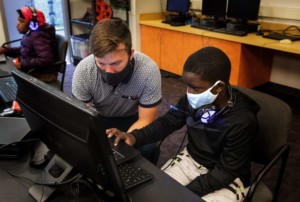How Can School and Community Leaders Support Deeper Learning?

The first responsibility of a leader is to define reality. The last is to say thank you. In between the two, the leader must become a servant and a debtor…The art of leadership requires us to think about the leader-as-steward in terms of relationships: of assets and legacy, of momentum and effectiveness, of civility and values. – Max DePree
Leaders facilitate answers to big questions. As DePree points out, that starts by defining reality. Addressing big question is what creates a legacy, momentum and effectiveness. How those questions are addressed defines values and culture.
Leaders build capacity for effective solutions. They invest in people and systems that move an organization toward the desired future state.
Leading in a Project-Based World
Things are moving fast. Young people will join a freelance economy where they work for themselves—or are encouraged to act as if they did—with a high level of self-direction and initiative. Many will work with diverse teams on projects resulting in public products.
Preparing students for a project-based world requires deeper learning experiences that value collaboration, creativity and critical thinking as well as communication and content knowledge. It requires high-quality project-based learning and other inquiry-based strategies that engage and challenge students.
As outlined in our most recent paper, preparing teachers for a project-based world requires personalized and project-based learning opportunities.
What kind of leadership makes it possible for students and teachers to thrive in this new environment? It starts with community conversations and answers to big questions.
System Leaders Facilitate Answers to Big Questions
1. What should graduates know and be able to do? The first job of a system head is to define outcomes. Some of that may be defined at state (or country) level, but that’s almost always a narrow and dated picture of preparation without compelling rationale. System heads should periodically hold community conversations about what it means to be Really Ready, the learning experiences likely to promote those outcomes and the metrics that would signal progress.
The strategic planning process can be broken into a series of projects that aspiring leaders can manage. Facilitating internal and external conversations toward strategic agreements is a great experience for aspiring school and system leaders.
2. What should be common across the system? School systems can operate as a unified enterprise (i.e., one learning model, platform and supports), a portfolio of autonomous schools or some mixture of the two (see our longer discussion on the topic). This decision impacts the rest of the strategic plan including platforms, support services, professional development and community partnerships. It determines the kinds and number of options available to families.
Promoting deeper learning through project-based learning and related strategies leads to the following questions:
- What model of project-based learning (e.g., Buck Gold Standard PBL)?
- How many projects? Integrated how? Assessed how? Presented how?
- How will personalized learning support projects?
3. How to build capacity for deeper learning? Projects are easy to do but hard to do well. The difference between thin activities and deeper learning experiences is good goals, good teachers with good tools and answers to these questions:
- How to support project libraries, project rubrics and tools and presentation and publication opportunities?
- How to provide students more real world experience and client feedback?
- How to give teacher leaders more project-based learning and leadership experiences?
Creating Conditions for Deeper Learning
“Several respected policy organizations, including the Council of Chief State School Officers, the Alliance for Excellent Education and the Learning Policy Institute, are focused on forging state education systems that encourage a broader view of student progress,” said Hewlett Foundation’s Barbara Chow. She notes that states are beginning to recognize both academic excellence and non-academic skills, and they are building capacity at every level so that the adults in the K-12 system have the resources, support and authority to be successful.
Policy makers and system heads can create conditions for deeper learning by:
- Supporting weighted funding that provides schools budgets that reflect actual challenges and by supporting youth and family services.
- Signaling support for broader aims without too quickly including immature measures in accountability systems.
- Supporting and authorizing innovative learning models.
Business leaders can support deeper learning by:
- Describing expectations (what grads should know) and trends.
- Sharing tools and techniques of managing work.
- Supporting students seeking work-based learning including job shadows and internships.
This blog is part of “It’s a Project-Based World” series. To learn more about this series and to learn ways that you can contribute, click the icon below to go to the Project-Based World page.

Join in the conversation at #projectbased.
For more, see:
- The Next Step to Paul Tough’s ‘Helping Children Succeed’
- 10 Roles of Effective Project-Based Learning Leaders
- It’s a Project-Based World. Let’s Prepare Students for It
Stay in-the-know with all things EdTech and innovations in learning by signing up to receive the weekly Smart Update. This post includes mentions of a Getting Smart partner. For a full list of partners, affiliate organizations and all other disclosures, please see our Partner page.







0 Comments
Leave a Comment
Your email address will not be published. All fields are required.